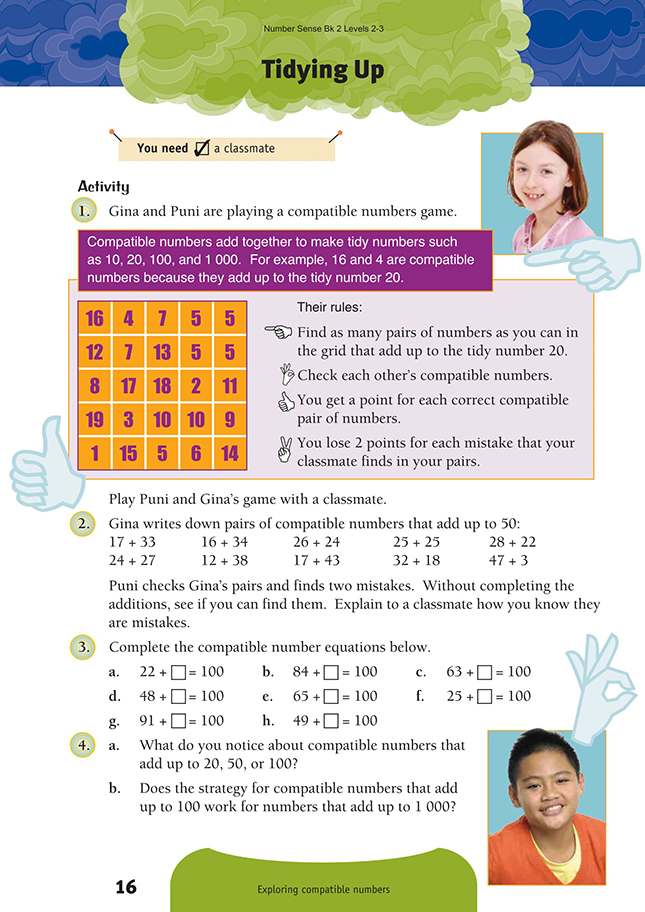This is a level 2 number activity from the Figure It Out series. It relates to Stage 5 of the Number Framework.
A PDF of the student activity is included.
Click on the image to enlarge it. Click again to close. Download PDF (253 KB)
find compatible numbers to 50
find compatible numbers to 100
Number Framework Links
Use this activity to:
• help the students who are beginning to use early additive strategies (stage 5) to become confident at this stage in the domain of addition and subtraction
• develop the students’ knowledge of tens and hundreds in numbers under 1 000 (place value, stage 5).
FIO, Levels 2-3, Number Sense and Algebraic Thinking, Book Two, Tidying Up, page 16
A classmate
This activity builds vital knowledge about compatible numbers that students can use as one of their part–whole strategies for solving addition and subtraction problems.
With a guided teaching group, materials such as 20- and 100-bead strings are ideal for showing the patterns in compatible numbers. Help the students to understand compatible numbers that add to 20 with questions such as: Separate the string of 20 into halves. How many beads are there in each half?
Begin a chart on the whiteboard, starting from the middle pair on the string, and describe the groups of beads as compatible numbers: 10 + 10 = 20. Have a student move 1 bead from one side to the other. Ask: What two compatible numbers have we made by shifting 1 bead? (9 + 11 = 20) Continue this to make a chart of compatible numbers that add up to 20:
10 + 10 = 20
9 + 11 = 20
8 + 12 = 20
7 + 13 = 20
6 + 14 = 20
Ask: How much does the difference between the two numbers change as we move 1 bead?
Use a 100-bead string to do the same with compatible numbers for 100, starting with
50 + 50 = 100, then having the students move the beads and record on a chart:
50 + 50 = 100
51 + 49 = 100
52 + 48 = 100
53 + 47 = 100
Ask: How much will the difference between the two numbers change if we move over 10 beads, and what compatible numbers will we make? (The difference will change by 20 as you move 10 beads.)
When the students are ready to move onto using imaging, have them imagine a 50-bead string. Get them to make a chart starting with half the beads on each side:
25 + 25 = 50
24 + 26 = 50
23 + 27 = 50
22 + 28 = 50, and so on.
To generalise number properties, have the students examine the numbers in the ones and tens columns for each pair of compatible numbers they find. Ask them to describe any patterns they find. They should see that the ones column has numbers that always make 10 exactly. They may also see that the tens column nearly always adds up to one 10 less than the number of tens we want to have in the target number. For example, if the target tidy number is 50, the tens digits must add up to 40. If the target tidy number is 100, the tens digits add up to 90. The exception is when the compatible numbers are themselves tidy numbers. For example, in 20 + 30 = 50 or in 30 + 70 = 100, the tens make the target tidy number because there is nothing in the ones place.
Question 4b extends the rule to include the hundreds column so that when the target number is 1 000, the hundreds must add up to 900 (unless, as explained above, the compatible numbers are themselves tidy numbers).
Answers to Activity
1. Practical activity. The compatible numbers are:
19 + 1, 18 + 2, 17 + 3, 16 + 4, 15 + 5, 14 + 6, 13 + 7, 12 + 8, 11 + 9, and 10 + 10.
2. 24 + 27 because 4 + 7 makes more than 10; and 17 + 43 because there are too many tens
3. a. 78
b. 16
c. 37
d. 52
e. 35
f. 75
g. 9
h. 51
4. a. Answers will vary. For 20, only 1 of the digits you are adding will have a 10, otherwise the result will go beyond 20. For 50, either the tens digits add up to 5 or the tens digits add up to 4 tens and the ones digits add to 10. For example, 27 + 23 = 4 tens + 10.
For 100, either the tens digits add up to 100 or the tens digits add up to 9 tens and the ones digits add up to 10. For example, 82 + 18 = 9 tens + 10.
b. Yes, the strategy for 100 works for 1 000.
However, it is slightly different because it is adding to 1 000, not 100. For example,
9 + 1 = 10, 90 + 10 = 100, 900 + 100 = 1 000. Two 3-digit numbers
should add up to 9 hundreds + 100. For example, 345 + 655 = 900 + 100, or
you may say 9 hundreds and 9 tens and 10 (900 + 90 + 10).
